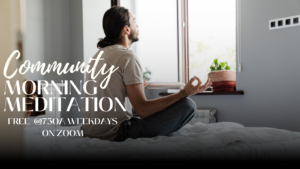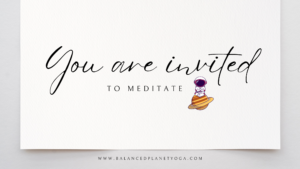Class Schedule

Autumnal Thoughts
As Autumn has arrived for her stay with us in preparation of the long cold nights of winter. We know this time of year is not only of harvest – The harvesting of the abundance of fruits of labor and storage of that abundance for preparation of those long cold nights of Winter — But it is also a time of release. We witness the trees shedding their offspring of leaves born just months ago for preparation of new growth to be re-born in the Spring. If we were to take this birth-live-release-rest cycle of life to our inner world —- from the gross (material) world to the subtle world — the one within – your True Self – the witness to your human existence – what would that world inspire you to release? Do you need to release something only born in the Spring of this current time – or do you need to release that which arrived in the Spring of many moons ago? What can you release now in this current Autumn of your life? What can you release now so that upon the arrival of Winter – the months of rest and solace for healing in preparation of the Spring – the time for rebirth and growth to be open for the joyous celebration in the shining sun of Summer? What can you release? If it takes a tree the cycle of a year to transform – understand that your healing journey is a process – one that needs to travel through seasons, whether by human standards or by the Devine – but a journey that cannot be travelled on, unless one travels through the cycle of birth, living, releasing and rest. Know this is my wish for you – not only may your sunrises hold more promise and your sunsets hold more peace but may you Release, Rest, Grow and Live. Know that I have so much love to give you. Namaste, Jenn Jenn Nehring is a 500HR RYT, completing Balanced Planet Yoga’s 200HR YTT + 300HR YTT – the Four Paths of Yoga. Jenn is also a trained trauma-informed yoga teacher, creating a safe + welcoming space for her students to heal in mind, body + spirit. You can find Jenn regularly on the schedule on Mondays at 530P, teaching vinyasa and trauma-informed Yoga monthly on Fridays at 530P, and she subs regularly in many other slots.

Embracing Loving Kindness: Reflecting on Our Journey + Introducing Vipassana Meditation
Reflecting on Loving Kindness Meditation Over the past eight weeks, we’ve embarked on a beautiful journey together, exploring the practice of Loving Kindness (Metta) meditation. This practice has guided us to cultivate a deeper sense of compassion, empathy, and unconditional love, not only for ourselves but also for others. It’s been heartwarming to witness the transformation and growth within our community as we collectively open our hearts. Let’s review Metta before we head into our next technique – Vipassana meditation. Benefits of Loving Kindness Meditation The benefits of Loving Kindness meditation are profound and far-reaching. Many of you have shared your experiences, highlighting the following: Buddhist Teachings on the Benefits of Loving Kindness According to the teachings of the Buddha, Loving Kindness meditation offers specific benefits, known as the “Eleven Benefits of Metta.” These are: Reflective Questions As we wrap up this module, it’s important to reflect on how Loving Kindness meditation has resonated with you. Here are some questions to ponder: Feel free to share your insights and experiences with us. Your reflections not only help you integrate the practice more deeply but also inspire and support others in their journey. Incorporating Loving Kindness Meditation Moving Forward To continue reaping the benefits of Loving Kindness meditation, consider integrating it into your daily routine. Here are a few tips: Introducing Vipassana Meditation As we conclude our Loving Kindness module, we are excited to introduce our next meditation practice: Vipassana meditation. History and Background of Vipassana Meditation Vipassana, which means “insight” or “clear seeing,” is one of the oldest forms of meditation, with roots tracing back to the teachings of the Buddha over 2,500 years ago. This practice was revived and popularized by S.N. Goenka in the 20th century and has since become a cornerstone of mindfulness and meditation practices worldwide. How Vipassana Relates to Loving Kindness While Loving Kindness meditation focuses on cultivating positive emotions and extending them outward, Vipassana meditation is about developing a deep, introspective awareness of our inner experiences. Both practices complement each other beautifully. Loving Kindness prepares the heart by nurturing compassion, while Vipassana sharpens the mind by fostering insight and understanding. Objectives of Vipassana Meditation The primary objectives of Vipassana meditation include: Acknowledging Our Inner Roommate In Vipassana meditation, we learn to acknowledge our “inner roommate”—the constant stream of thoughts, emotions, and sensations that inhabit our mind. Through a process of self-witnessing, we observe these inner experiences without attachment or aversion. This practice helps us develop the ability to resist judgment and become fully present in each moment, whether that moment is pleasant, unpleasant, or neutral. The Ultimate Goal of Vipassana Meditation The ultimate goal of Vipassana meditation is to attain liberation from suffering by developing deep insight into the true nature of reality. By understanding the impermanent, unsatisfactory, and selfless nature of all phenomena, we can transcend our habitual patterns of craving and aversion, leading to profound inner peace and enlightenment. This journey of self-discovery and transformation allows us to live more fully in the present moment, free from the attachments and aversions that cause suffering. Guidance Text: “Mindfulness in Plain English” To guide us in our Vipassana meditation practice, we will be using the text Mindfulness in Plain English by Bhante Henepola Gunaratana. This book is a comprehensive and accessible resource that breaks down the principles and practices of Vipassana meditation in a clear and practical manner. It is an excellent tool for both beginners and seasoned practitioners, providing valuable insights and techniques to deepen our meditation practice. Join Our Morning Meditation There are many different tools and techniques in meditation. Our morning meditation is an opportunity to experience these techniques at no cost to see what practice is right for you. It is also a really great way to start the day, in a community that supports each other. Please join us on weekday mornings at 7:30 a.m. for a 7-minute guided Vipassana practice. The class is on Mindbody, or you can email us for Zoom information. As we embark on this new journey, we encourage you to approach Vipassana meditation with an open mind and heart. Just as with Loving Kindness, patience and consistency are key to experiencing the transformative benefits of this practice. We are thrilled to continue this journey of self-discovery and growth with you.

Free Online Meditation Classes at BPY
Set the Tone for Your Day in 7 Minutes: Join Our Free Online Meditation at Balanced Planet Yoga In a world that’s constantly buzzing with activity, finding moments of tranquility can seem like an elusive dream. Yet, amidst the chaos, it is possible to create space to check-in and create some calm in the storm. One such place is here, at Balanced Planet Yoga, where we meet weekday mornings on Zoom at 730 am to start our day with a community guided free online meditation. We have been going strong since January 1st, and if you are looking for a better way to start your day, you may have just stumbled upon it. Since January 1st, our virtual doors have been open wide to all, offering a brief mindful pause each morning to help set the tone of our day. In just seven minutes, we take a collective voyage, transcending boundaries of time + space to commune in the timeless practice of meditation. Designed to seamlessly integrate into the rhythms of your bustling life, our sessions are tailored to accommodate the busiest of schedules, ensuring that anyone, anywhere, can carve out the time to meet the community for our free online meditation program. At Balanced Planet Yoga, we understand the demands of modern living all too well. The relentless pace of life can leave us feeling drained, disconnected, + overwhelmed. That’s why we’ve crafted our morning meditation sessions to be a short 7 minute check-in—a gentle reminder that amidst the chaos, there exists a peaceful place within each of us, waiting to be discovered at any moment. And, that this place exists in everyone we meet. Each session is a unique exploration, drawing from a rich variety of meditation techniques and hosted by your BPY teachers and fellow community members. From mindful breathing to guided visualizations, from loving-kindness practices to body scan meditations and more, we traverse the vast landscape of inner exploration, guided by seasoned practitioners who hold space for each participant with compassion + grace [and if you are interested in leading a session with our community, reach out to us here]. We are humbled by the opportunity to serve our community and hopefully beyond, extending a heartfelt invitation to all who is curious about this practice – whether you’re a seasoned meditator or a novice, our online meditation sessions are open to everyone [whether you are a member of the studio or not!], regardless of age, background, or experience level. As we continue to navigate the ever-changing currents of life, our commitment to spreading the transformative power of meditation remains unwavering. We invite you to join us on your journey of self-discovery, as we cultivate inner peace, resilience, and connection—one breath at a time. Spread the word, share the light, and together, let’s create a ripple of positivity that resonates far beyond the confines of our brick + mortar as well as our virtual studio walls. Join us at Balanced Planet Yoga, where seven minutes of online meditation can transform your day—and perhaps, even your life. To learn more about this program, visit our MindBody Platform.

